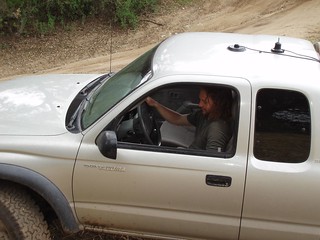Review: Tacoma as a camper
2013-10-16
We've had Jane (our truck) for some time now, and it just occured to us that we should write a review. The reason this is worthwhile isn't to talk about how great our truck is, but for others thinking of doing something similar there are some details that aren't necessarilly obvious until you try it. So here goes.
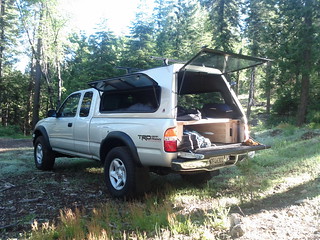
We've had Jane for a couple years. I've been living out of the truck since mid may, so about 5 months now. Before that we used her regularly for trips to the mountains, including ski and backpacking trips.
Besides driving places and carrying out junk around with us we have two major additional uses for this vehicle. The first is as a place to sleep in urban areas. The second is as a place to sleep in remote areas in inclement weather or when we don't want to deal with setting up a shelter.
Jane is a manual extended cab 2002 Toyota Tacoma with a 2.7L engine a 2.5" lift I installed myself and a sleeping platform I built. With that dealt with lets get down to the nitty gritty:
The Good
Offroad:
 High clearance is AMAZING for boondocking. Recently I was driving across Nevada. The clouds had been making "it's going to rain" patterns all day. It was late and I was ready to sleep. As I drove down the highway I saw on the side a pulloff with a tiny dirt road leading off into the desert... so I took it. In just a couple minutes I was out of view and sound of the highway in the middle of the nowhere in the beautiful Nevada desert. After a nice evening walk I curled up in the back of the truck for a great night's sleep.
High clearance is AMAZING for boondocking. Recently I was driving across Nevada. The clouds had been making "it's going to rain" patterns all day. It was late and I was ready to sleep. As I drove down the highway I saw on the side a pulloff with a tiny dirt road leading off into the desert... so I took it. In just a couple minutes I was out of view and sound of the highway in the middle of the nowhere in the beautiful Nevada desert. After a nice evening walk I curled up in the back of the truck for a great night's sleep.
This is an extremely common story for us. Not driving late at night is a major reason we got the vehicle originally. These sorts of locations are our favourite campsites. The ones where we can really get out and away from people. Where no-one will bother us. Where we're already at a great spot to start hikes, gather food, etc.
 In these cases I need a vehicle that I know will have no problems on my way in. This is where the clearance comes in handy. Jane is a little overkill for this type of case and any reasonable truck or higher-clearance van is sufficient for the bulk of locations. Though I've certainly used the additional clearance a few times. OHV parks can be a great source of boondocking locations for example.
In these cases I need a vehicle that I know will have no problems on my way in. This is where the clearance comes in handy. Jane is a little overkill for this type of case and any reasonable truck or higher-clearance van is sufficient for the bulk of locations. Though I've certainly used the additional clearance a few times. OHV parks can be a great source of boondocking locations for example.
In the Nevada story given the weather there's no way I would've gone down that road without a decent offroad tire and 4wd in addition to the clearance. Had it been a torrential downpour that road could've easily turned to mud, and I'd be stuck waiting for it to dry up... or worse the spot I was in could flood too with my vehicle immobilized. Even after it dries up rain can easily turn a drivable road into a boulder field.
The point is, I don't just need a vehicle capable of getting into great camping spots, but also of capable getting out again. It's not like 4-wheeling where we'd have a friend there to pull us out. The nature of boon-docking is that necessarily no-one knows quite where we are, since we're basically always out searching for campsites. Because of that it's important to have a vehicle that's a little overbuilt. I should note that we also have a small pile of recovery gear such as a highlift jack, saw, and strong rope, along with some decent knowledge of how to use it. The photo below is my clearing a log off a road using a jerk strap.
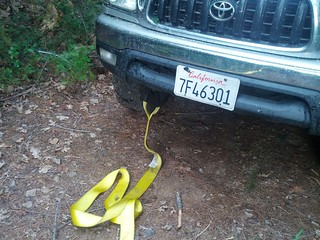
Note that a low range is absolutely critical. It's all the more so because we slightly upsized the tires (giving the diffs and axles slightly more clearance and the truck a little more traction and flotation). I find myself using low-range particularly frequently in reverse, which is higher than 1'st. Often if I've stupidly gone down a hill on a steep dirt road I end up having to back out. Without a low-range the engine would just die, or even if I could manage to move I'd probably smoke the clutch and move too fast thus running into something.
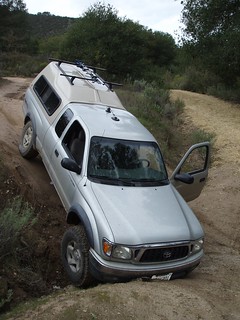
As a minor note the non-stock rear bumper you see in all the photos has been pretty useful. I've backed into trees a couple of types by accident with no damage being done.
Space:
The platform we've built is really nice. As it turns out it's sufficient to fit two stacked rubbermade boxes underneath, and requires no support structure which would take weight and space. This has been huge for me, and even more useful now that Jess has moved in as well. We gave in and got a storage unit so we can swap out some of our stuff occasionally because even pairing it down we just have too many interests to fit it all. But, as we slowly get organized we can fit not only enough stuff to camp and eat delicious and cheap food, and do SAR, but also some space for gathering, crafts, archery equipment, etc.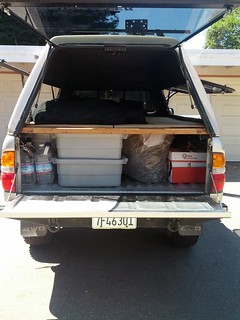
Note that the hightop cap is really necessary for this setup to work well. Otherwise we'd have so little space in the sleeping area that it would be really annoying getting in and out.
Cap:
The windoors are a huge advantage. We frequently reorganize things in the top by opening them and reaching in. In good weather if we aren't stealthing we'll open them up for sleeping as well, which can be very nice. We use the sliding screen windows a lot as well, especially in colder weather where we want the truck cap to breath a little, but we don't want it so drafty.
The carpeting inside the cap has several unexpected advantages. It seems to discourage condensation, so the cap doesn't drip even if we close it all the way up on a cold or rainy night. The carpeting also adds a bit to the insulation ability of the cap, allowing the two of us to heat it up with our body heat in below freezing weather to warm enough we can be relatively comfortable out of our sleepingbags naked. It's not warm not enough to sleep without a bag, but it makes things a lot safer if our bags are compromised or we're wet, it's also just nice. Lastly it works as the passive side of velcro! This means we can stick things to the inside of the cap like curtains, a net to store our curtains, my pee bottle, etc.
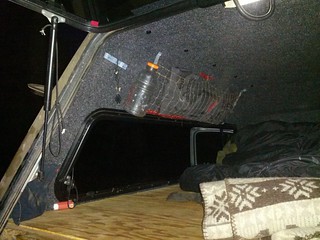
Extended cab pickup truck:
Tailgates are AWESOME. It's a place to sit, a place to cook, etc. It means that as soon as you park you've got a surface to work on. It's stable and even extremely useful for woodworking.
Having a seperate cab and sleeping space has some major advantages. For example, if we have something smelly in the back for a short time, we don't smell it in the front. I don't like to put a gas can back there, but it's an option. The heater can warm up the front much faster due to it's size.
We got an extended cab so we could pick up hitchhikers. This and giving rides to friends has come up a number of times, but an additional advantage is the ability to have food and such in the cab. On long roadtrips shotgun can reach around and grab some food or water making everyone happier during the rive.
Downside
Seperate cab and sleeping space
The cab and sleeping space are totally seperate. This means it's not uncommon to wake up in the morning in the cap and look out and see for example that there's snow on the ground and then realize that your shoes are in the cab and there's no way to get to them. It should be noted that on the 2003 model with double sliding windows I could get from the cap to the cab directly by removing the removable front window of the cap. Sadly I don't fit through the rear window of the cab on the '02. oops!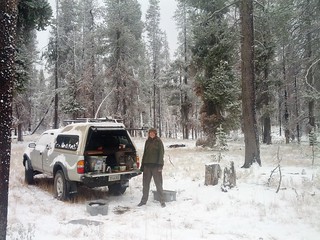
Insufficient space
We still have a storage unit. I've toyed with putting an additional rack over the cab with a basket so we can carry more stuff, but that would impact gas milage and it's not clear that it's worth it. Also, we have to watch the weight bringing us to the next point.Engine is kindof small
Usually this isn't a problem, but it does mean that we really can't tow at all. You have to be pretty aggressive with shifting as well and I've found myself running her at 4000rpm for a time once or twice to keep her going at a safe speed up a hill which will no doubt shorten the engine's lifespane. If it weren't manual it wouldn't be drivable at all when loaded. It also means that when you get her stuck it's trickier to get her out without burning the clutch. This has also limited how much we can load her down with. Adding a roofrack for example wouldn't help us much since we're limited by weight. And lastly it means I can't put any more armor on the truck to protect her when I do something stupid offroad.It's tall
The hight is sufficient with the lift, oversized tires, hightop cap, roofrack, and highlift jack on the roof, that we can't fit in parking structures. This is a very rare annoyance actually, but it's bothered us once or twice at the airport where we can't fit in short-term parking. On the upside, we can spot the truck across a large parking lot no problem, and it's *still* shorter than many vehicle on the road.Other Modifications
Wiring
I added a 12V socket in the back that's always on, this is EXTREMELY useful. I can run a laptop and sit on the tailgate or lie in the back, or I can charge my cellphone overnight.Compass
We have a compass on the front dash. I often look at it when I get a little turned around just to figure out whether a left turn is north or south. For this it really doesn't need to be the precise at all, which is good since the engine creates a variable magnetic field, so it'll never be really precise. I can't tell you how many times I've been driving down a road and said "I wonder if I made a wrong turn" looked down and see I was driving 180 degrees off.Broken door dinger
I intended to bypass it but instead accidentally broke the button. It's a little button on the door that tells the truck if the door is open or not. I like to listen to music while doing some tasks by opening the doors and cranking the stereo... this works poorly if the car is going "YOUR DOOR IS OPEN, YOUR DOOR IS OPEN, PLEASE CLOSE IT!" So I broke that switch. Having broken that switch also caused the automatic dome-light to stop working, but we never used the auto-mode anyway because it blows your night vision when you don't want it too.Keyway "mod"
The keyway also broke such that you can now remove the key while it's ACC mode. This is really useful actually since it means I can unlock the back of the truck while leaving the radio playing or my laptop running off the front sockets. In an automatic this feature would scare me a little... 'cause what if the key falls out and you can't turn the car off! But in a manual you can always just kill the engine easily enough.Conclusions
Overall this has been an amazing vehicle for us, both when living in a house and when living in the truck. I can't see ever owning a vehicle with this purpose that isn't 4wd and high-clearance, and even the extra lift has been completely worth it for the extra safety factor it gives us. The gas mileage is great, and having it be compact enough to get down tiny roads is incredibly useful. I love the lack of power windows and such and the ability to do things like roll the windows down after the car is off. If we were to do it again Jess and I agree that we'd probably go for the larger 3.4L 6-cyl despite it being marginally less reliable. I'd also try and find one with break-away mirrors. So far we haven't smashed one of ours, but it make me nervous having them hard-mounted to the body.
The vehicle is relatively subtle. It's obviously a lifted truck so not super subtle in some cities, but out in the country it's a vehicle people expect to see in random places. This is very useful when stealthing.
Gas milaage is about 19mpg. Not bad for an offroad house. Will we live in it forever? No, probably not. Will we keep using similar vehicles for camping, road-trips, and even months of travelling? It's pretty likely, at least until we decide to do everything by mule ;D.
